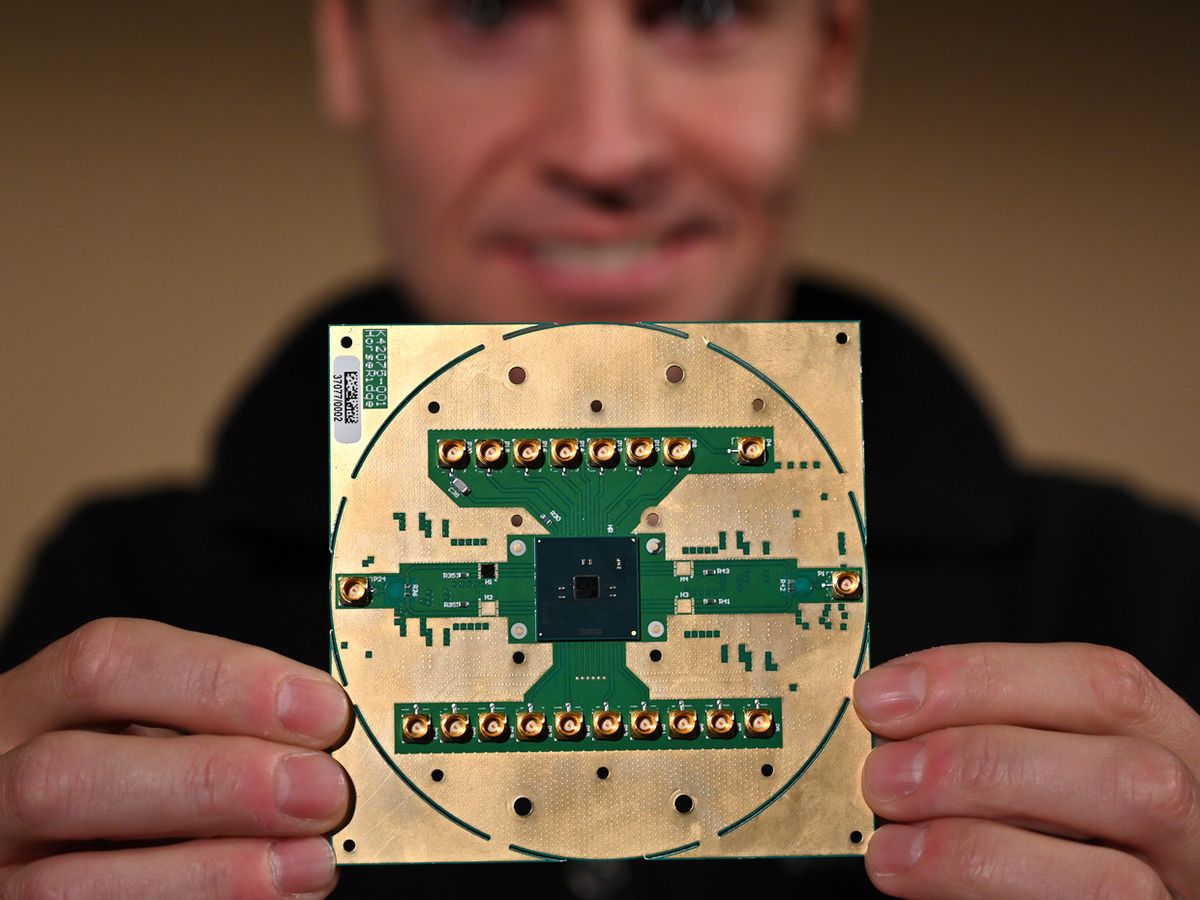As researchers strive to boost the capacity of quantum computers, they've run into a problem that many people have after a big holiday: There's just not enough room in the fridge.
Today's quantum-computer processors must operate inside cryogenic enclosures at near absolute zero, but the electronics needed for readout and control don't work at such temperatures. So those circuits must reside outside the refrigerator. For today's sub-100-qubit systems, there's still enough space for specialized cabling to make the connection. But for future million-qubit systems, there just won't be enough room. Such systems will need ultralow-power control chips that can operate inside the refrigerator. Engineers unveiled some potential solutions in December during the IEEE International Electron Devices Meeting (IEDM), in San Francisco. They ranged from the familiar to the truly exotic.
CryoCMOS
Perhaps the most straightforward way to make cryogenic controls for quantum computers is to modify CMOS technology. Unsurprisingly, that's Intel's solution. The company unveiled a cryogenic CMOS chip called Horse Ridge that translates quantum-computer instructions into basic qubit operations, which it delivers to the processor as microwave signals. Horse Ridge is designed to work at 4 kelvins, a slightly higher temperature than the qubit chip itself, but low enough to sit inside the refrigerator with it. The company used its 22-nanometer FinFET manufacturing process to build the chip, but the transistors that make up the control circuitry needed substantial reengineering. “If you take a transistor and cool it to 4 K, it's not a foregone conclusion that it will work," says Jim Clarke, director of quantum hardware at Intel. “There are a lot of fundamental characteristics of devices that are temperature dependent." Others are working along the same lines. Google presented a cryogenic CMOS control circuit earlier in 2019. In research that was not yet peer-reviewed at press time, Microsoft and its collaborators say they have built a 100,000-transistor CMOS control chip that operates at 100 millikelvins.Microrelays
In logic circuits, transistors act as switches, but they aren't the only devices that do so. Engineers in Tsu-Jae King Liu's laboratory at the University of California, Berkeley, have developed micrometer-scale electromechanical relays as ultralow-power alternatives to transistors. They were surprised to discover that their devices operate better at 4 K than at room temperature. At room temperature, the devices suffer some mechanical peculiarities. First, ambient oxygen can react with the relay's electrode surfaces. Over time, this reaction can form a high-resistance layer, limiting the device's ability to conduct current. But at cryogenic temperatures, oxygen freezes out of the air, so that problem doesn't exist. Second, the contacts in microscale relays tend to stick together. This shows up as a hysteresis effect: The relay opens at a slightly different voltage than the one at which it closes. But because the adhesive forces are weaker at cryogenic temperatures, the hysteresis is less than 5 percent of what it is at room temperature. “We didn't suspect ahead of time that these devices would operate so well at cryogenic temperatures," says Liu, who led the research presented at IEDM by her graduate student Xiaoer Hu. “In retrospect, we should have."Single-flux quantum logic
Hypres, in Elmsford, N.Y., has been commercializing cryogenic ICs for several years. Seeking to steer its rapid single-flux quantum (RSFQ) logic tech into the realm of quantum computing, the company recently spun out a startup called Seeqc. In RSFQ and its quantum version, SFQuClass logic, quantized pulses of voltage are blocked, passed, or routed by Josephson junctions, the same type of superconducting devices that make up most of today's quantum computer chips. In 2014 physicists at University of Wisconsin–Madison first suggested that these pulses could be used to program qubits, and Seeqc's scientists have been collaborating with them and Syracuse University scientists since 2016. Seeqc is now designing an entire system using the technology: a digital-control, error-correction, and readout chip designed to work at 3 to 4 K and a separate chip designed to work at 20 millikelvins to interface with the quantum processor.Weyl semimetals
Quantum computing is already strange, but it might take some even stranger tech to make it work. Scientists at Lund University, in Sweden, and at IBM Research–Zurich have designed a new device called a Weyl semimetal amplifier that they say could bring readout electronics closer to the qubits. Don't worry if you don't know what a Weyl semimetal is. There are things about these materials that even the scientists trying to make devices from them don't fully understand. What they do know is that these materials, such as tungsten diphosphide, exhibit extremely strong, temperature-dependent magnetoresistance when chilled to below about 50 K. The device they simulated has a gate electrode that produces a magnetic field inside the Weyl semimetal, causing its resistance to go from tiny to huge in a matter of picoseconds. Connecting the input from a qubit to the device could make a high-gain amplifier that dissipates a mere 40 microwatts. That could be low enough for the amplifier to live in the part of the fridge close to where the qubits themselves reside.This article appears in the February 2020 print issue as “4 Ways to Handle More Qubits."
Samuel K. Moore is the senior editor at IEEE Spectrum in charge of semiconductors coverage. An IEEE member, he has a bachelor's degree in biomedical engineering from Brown University and a master's degree in journalism from New York University.



